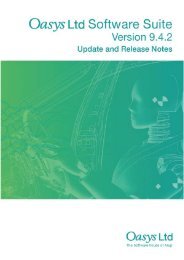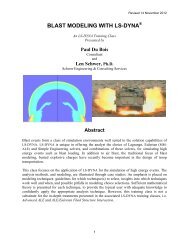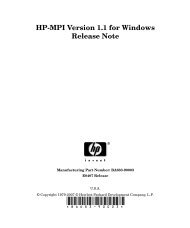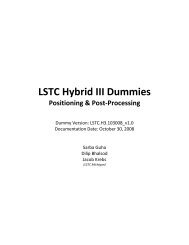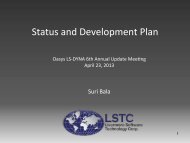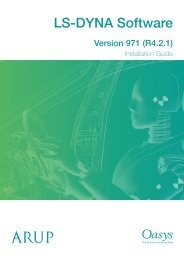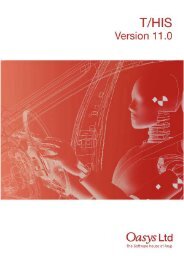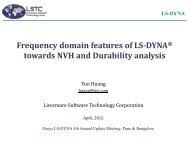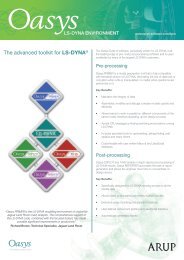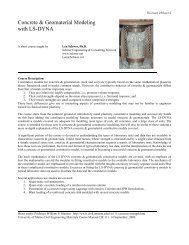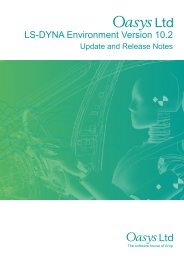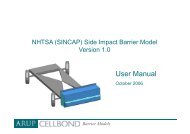Oasys LS-DYNA Environment 8.1 VOLUME 3 ... - Oasys Software
Oasys LS-DYNA Environment 8.1 VOLUME 3 ... - Oasys Software
Oasys LS-DYNA Environment 8.1 VOLUME 3 ... - Oasys Software
You also want an ePaper? Increase the reach of your titles
YUMPU automatically turns print PDFs into web optimized ePapers that Google loves.
<strong>Oasys</strong> <strong>LS</strong>-<strong>DYNA</strong> <strong>Environment</strong>: User Guide (Version <strong>8.1</strong>)<br />
15.0 IMPOSED MOTION<br />
Certain features in <strong>LS</strong>-<strong>DYNA</strong> work by imposing motion on nodes. If two different features<br />
attempt to impose motions on the same node, problems will arise. Not all such clashes give rise<br />
to error messages. The problem rarely causes the analysis to crash but almost always gives<br />
wrong results. Examples of "imposed motion" features are:<br />
*BOUNDARY all types, including all restraints and displacement, velocity and<br />
acceleration boundary conditions<br />
*CONSTRAINED all types including SPOTWELD but not JOINT<br />
*CONTACT types 1, 2, 6, 7, 17 and 18 but not other types<br />
Rigid bodies (i.e. elements made of parts which reference a *MAT_RIGID)<br />
*INTERFACE<br />
*RIGIDWALL<br />
No node should have more than one of the above attached to it. For example, it is an error to<br />
include the same node on two rigid bodies, or to attempt to impact a rigid body against a<br />
stonewall (but note possibility of using RWPNAL on *CONTROL_CONTACT), or to include<br />
a restrained node in a set of constrained nodes, or to spotweld onto a rigid body. However, the<br />
x, y and z degrees of freedom are treated independently, and it is possible, for example, to<br />
restrain a node in x and constrain the same node in y.<br />
Some error checking is done for clashes between "imposed motion" features, but the checking<br />
is not comprehensive. A typical symptom of the problem is that supposedly constrained nodes<br />
drift apart.<br />
Options are available for rigid bodies which overcome certain of these problems - see Section<br />
7.<br />
The most commonly used contact surface types (3, 13 and 5) do not impose motion and hence<br />
do not suffer from the problems described above. They can be used with rigid bodies and can<br />
be overlapped such that nodes are on more than one contact surface.<br />
Page 15.1



